The History Of Baptiste Lake
Historical Context
Baptiste Lake is located in the granite highlands
south of Algonquin Provincial Park.
The lake gets its name from Algonquin
Chief Jean Baptiste, believed to be the first
permanent resident.
Baptiste Lake and its surroundings are situated within the Grenville Province of the Canadian Shield, which is a northeasterly trending belt about 250 miles wide (from upper New York State to just south of Sudbury) and 1,200 miles long, extending from Lake Huron to the Labrador coast. A continental collision deformed the crust of the earth about a billion years ago, pushing up a mountain range along a line running roughly through Parry Sound, Haliburton, Bancroft, Pembroke and on to the Gatineau Hills of Quebec. This mountain chain, once as high as the Rocky Mountains, has been reduced by erosion to what are today the highlands around Baptiste Lake.
Baptiste Lake and its surroundings are situated within the Grenville Province of the Canadian Shield, which is a northeasterly trending belt about 250 miles wide (from upper New York State to just south of Sudbury) and 1,200 miles long, extending from Lake Huron to the Labrador coast. A continental collision deformed the crust of the earth about a billion years ago, pushing up a mountain range along a line running roughly through Parry Sound, Haliburton, Bancroft, Pembroke and on to the Gatineau Hills of Quebec. This mountain chain, once as high as the Rocky Mountains, has been reduced by erosion to what are today the highlands around Baptiste Lake.
Aboriginal Peoples
It is documented that the Mississauga Nation
of the area entered into a provisional
treaty in 1819, in Kingston, with John Ferguson,
on behalf of the Crown, through
which they "freely and voluntarily surrendered"
their lands to the Crown for an annual
payment of 642 pounds and ten
shillings, in perpetuity. A confirmatory
treaty was signed in 1822. The Chippewa
Nation entered a similar provisional treaty
in 1818 for a yearly sum of 1,200 pounds,
which was confirmed in 1832.
Presently, some land claims in the area remain outstanding, particularly those of the Golden Lake Algonquin. Some of the first known Aboriginal families to live on Baptiste Lake were the Bernards, LaVallees and Baptistes.
Presently, some land claims in the area remain outstanding, particularly those of the Golden Lake Algonquin. Some of the first known Aboriginal families to live on Baptiste Lake were the Bernards, LaVallees and Baptistes.
Exploration
Early European explorers of the area include
Lieutenant Walpole, who in 1827 was
sent to map a canoe route from Lake Simcoe
through Baptiste Lake, the York and the
Madawaska Rivers. The first survey of the
region was completed in the summer of
1853, mainly for the construction of the
Hastings Road. In August 1857, John
Snow was instructed to survey a road from
the Mississippi River in the Township of
North Sherbrooke in Lanark County to the
Hastings Road at what is now Bancroft. It
is known in Bancroft as the Snow Road.
In 1864, land surveyor A.B. Perry was sent to scout the lake area for potential resources and habitation. He reported the land quite unsuitable for habitation, but noted the enormous stands of white and red pine. After traveling the 25-mile stretch of waterway, he named the current Baptiste Lake as "Long Lake". His report reached the Bronson and Weston Company, which led to industrial logging in the area.
In 1864, land surveyor A.B. Perry was sent to scout the lake area for potential resources and habitation. He reported the land quite unsuitable for habitation, but noted the enormous stands of white and red pine. After traveling the 25-mile stretch of waterway, he named the current Baptiste Lake as "Long Lake". His report reached the Bronson and Weston Company, which led to industrial logging in the area.
Logging And Lumbering
The first logging camps of the 1800s had
one large windowless building called a
camboose that housed about 50 men. It
was made of pine logs, with a floor of flattened
poles and a chimney of black
spruce poles. Over time, the camps grew
larger, with more buildings able to house
up to 125 men that were separate from
the cookhouse and blacksmith shop with
stable. A 40-foot pointer boat, designed
by John Cockburn in the 1850s, could
carry 8,500 pounds of groceries to feed
80 men. Larger camps had four cooks,
labourers, teamsters to drive the horses,
timekeepers and a doctor, for which each
man paid 50 cents a month.
Logging took place only during the winter. Logs were skidded by horse onto thousands of frozen lakes, including Baptiste Lake, and then piled to await spring. After the spring thaw, each lake harboured log booms ready for river driving. Dams were built by lumbermen to hold waters up to their highest levels, and once they were open, at the lake head, water flowed through the system to carry the timber to the mill.
Logging took place only during the winter. Logs were skidded by horse onto thousands of frozen lakes, including Baptiste Lake, and then piled to await spring. After the spring thaw, each lake harboured log booms ready for river driving. Dams were built by lumbermen to hold waters up to their highest levels, and once they were open, at the lake head, water flowed through the system to carry the timber to the mill.
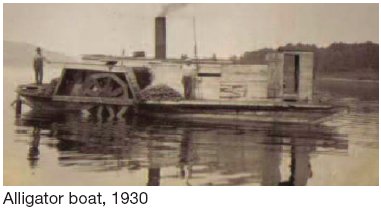
Later, Alligator boats (small side-wheelers) hauled booms of up to 60,000 logs, and could crawl across bogs from one lake to another. They were flat-bottomed scows, and they carried about a mile of cable on board, which they used to pull themselves over land by winding up a cable anchored to a point some distance away. A steam side-wheeler, the Beaver, was on Baptiste Lake since at least 1917, when Sam Baptiste was the captain. When Martin acquired the vessel in 1930, he replaced the steam engine with a more efficient diesel engine from a bulldozer and the vessel was renamed the Alligator, which continued to ply the waters of Baptiste Lake until the 1950s. It trailed a span of logs 15' wide by 1,000' long, and made its daylong trip from the upper region of the lake to the mill site, at what is now the Baptiste Lake Marina. High-speed boats and issues of liability with large log booms led to the retirement of the Alligator and the closing of the Martin Mill.
In 1864, the Bronson and Weston Company of Ottawa launched a major logging operation in the upper region of Baptiste Lake. A second Ottawa firm, Wm. Mason & Sons, began a lumbering operation in 1887. Many of the early settlers worked in logging camps during the winter, from the first snow to the spring thaw, to add to their meager income from questionable farmland.
When the Bronson & Weston Company first began logging at Baptiste Lake, it operated from the headwaters near the entrance to Algonquin Park. In order to be able to drive logs down the river, the company built the first dam at the lower end of the lake in 1866, approximately one kilometer above where High Falls dam is today. The rising water connected the upper and lower basins of the lake, creating islands where none before existed, and making the log drive easier. This also had the effect of increasing flooding in Bancroft, and in 1932 a second dam, built of cement by Ontario Hydro (and still visible near the current dam), replaced the old wooden structure. Flooding persisted, and in 1967 the current High Falls dam was built, which has solved the flooding problems, for the most part.
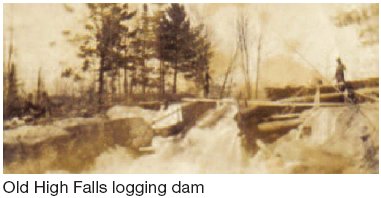
When the Irondale, Bancroft and Ottawa Railway (IB&O) Railway reached Baptiste Station, sawmills opened on Baptiste Lake, such as the William Hughes Mill on the lower basin of the lake, which became the Jennings and King Mill in 1914. Ownership of the mill changed to Jennings & Bailey, and in 1921 Whitney Martin joined the firm. Bailey bought out Jennings, and when Bailey moved to start a mill in Haliburton, Martin and his brother Garfield purchased the company, forming Martin Brothers Lumber Company. In 1930, they purchased the Hughes Mill and operated two mills on Baptiste Lake employing up to 200 people. One mill was on the site of the current Baptiste Lake Marina.
When his son Grenville bought the upper mill in 1957, Whitney dismantled the lower mill, and created major cottage developments on new roads named Marina Road, McAllister Island, and Golden Shores. Under the direction of Grenville Martin, the Harcourt operation expanded, and G.W. Martin Company grew to become the largest producer of hardwood in Canada. At its peak, with annual revenues of $100 million, the company employed 1,300 people. The company closed following the death of Grenville Martin, who perished in a private airplane accident in 1984.
Settlement
The earliest settlers to Hasting County were
United Empire Loyalists who were allied with
the British during the American Revolution,
but few of them ventured as far north as
Baptiste Lake. It was not until the 1840s
and 1850s that waves of immigrants, many
of them escaping the Irish potato famine,
chose to live in the newly surveyed townships
in northern Hastings County. Names
such as Wicklow and McClure attest to the
region's Irish heritage.
Prompted by government advertisements of prosperity and rural serenity, posted in Britain and Canadian cities, and offers of free land (100 acres, offered under the terms of The Free Grant and Homestead Act, 1868), settlers pushed their way north. Under the terms of the legislation, settlers had to be 18 years of age, build a log house of 20' by 18' within four years, and have at least 12 acres under cultivation within four years. Roofs were made of bark and log walls were filled in with clay and whitewashed. Colonization roads, such as the Peterson Road, were built and opened areas for settlement. On December 8, 1870, "more than 100 Freeholders and Resident Householders" petitioned the County of Hastings for the right to amalgamate, and five communities were consolidated into one Municipal Corporation.
The first permanent resident on Baptiste Lake is believed to be Chief John Baptiste, who moved from the Lake of Two Mountains near Montreal in the mid 1800s. He received the first land grant, believed to be in the area of Lavallee Bay, and as such the lake was renamed Baptiste Lake from Long Lake. His son, John Baptiste, also received a land grant and settled midway on the channel on the north shore of the main basin. One of John's daughters, Mary, married Frank Lavalley and then built a home in the area that was then known as Lavalley Bay.
William Mulcahey, an Irishman, is believed to be the first non-Aboriginal resident on the lake. In the late 1800s, on the brow of a hill on the south shore of Baptiste Lake, he cleared land for farming. Further to the east, he built a large and elegant home, which now continues as the main lodge of Birch Cliff Lodge. The IB&O Railway reached the south shore of Baptiste Lake and his property in 1900, and by 1904 the first "tourists" were coming to Baptiste Lake. Five of those initial tourists banded together and purchased the first cottage lots. Mulcahey built a general store shortly thereafter on the hill overlooking Baptiste Station below. He provided a dining room for loggers, trainmen and travelers passing through, in addition to boarding rooms located above the store and boxcar cabins located nearby for overflow guests.
Prompted by government advertisements of prosperity and rural serenity, posted in Britain and Canadian cities, and offers of free land (100 acres, offered under the terms of The Free Grant and Homestead Act, 1868), settlers pushed their way north. Under the terms of the legislation, settlers had to be 18 years of age, build a log house of 20' by 18' within four years, and have at least 12 acres under cultivation within four years. Roofs were made of bark and log walls were filled in with clay and whitewashed. Colonization roads, such as the Peterson Road, were built and opened areas for settlement. On December 8, 1870, "more than 100 Freeholders and Resident Householders" petitioned the County of Hastings for the right to amalgamate, and five communities were consolidated into one Municipal Corporation.
The first permanent resident on Baptiste Lake is believed to be Chief John Baptiste, who moved from the Lake of Two Mountains near Montreal in the mid 1800s. He received the first land grant, believed to be in the area of Lavallee Bay, and as such the lake was renamed Baptiste Lake from Long Lake. His son, John Baptiste, also received a land grant and settled midway on the channel on the north shore of the main basin. One of John's daughters, Mary, married Frank Lavalley and then built a home in the area that was then known as Lavalley Bay.
William Mulcahey, an Irishman, is believed to be the first non-Aboriginal resident on the lake. In the late 1800s, on the brow of a hill on the south shore of Baptiste Lake, he cleared land for farming. Further to the east, he built a large and elegant home, which now continues as the main lodge of Birch Cliff Lodge. The IB&O Railway reached the south shore of Baptiste Lake and his property in 1900, and by 1904 the first "tourists" were coming to Baptiste Lake. Five of those initial tourists banded together and purchased the first cottage lots. Mulcahey built a general store shortly thereafter on the hill overlooking Baptiste Station below. He provided a dining room for loggers, trainmen and travelers passing through, in addition to boarding rooms located above the store and boxcar cabins located nearby for overflow guests.
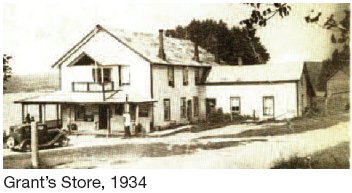
Later, he sold the store to Hiram and Elizabeth
Grant, who with their daughter Mabel ran
the store and post office for many years
before they sold it in turn to Bruce Montgomery
in 1984. Under new ownership in
2001 by George and Susan Poulton, the
old store was demolished and a new, railway-
themed facility established (Country
Fare Inn), with a general store, a restaurant,
and guest rooms.
By 1911, with a store, a school at the top of Station Hill, a church on Bowen Road, and new settlers arriving, Mulcahey's vision of a village on Baptiste Lake was fulfilled (It should be noted that the church was moved, board by board, from its place on the hill and rebuilt on its present location on land donated by Mrs. Hiram [Elizabeth] Grant).
By 1911, with a store, a school at the top of Station Hill, a church on Bowen Road, and new settlers arriving, Mulcahey's vision of a village on Baptiste Lake was fulfilled (It should be noted that the church was moved, board by board, from its place on the hill and rebuilt on its present location on land donated by Mrs. Hiram [Elizabeth] Grant).
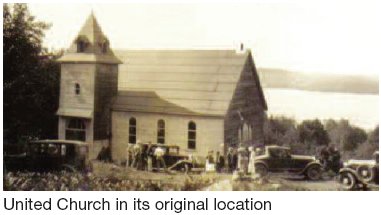
Mulcahey decided to
open up cottage lots and extend the road
to the east of his house. The new development
became Fell Road. The first person to
build a cottage was John Payne. He and
his wife Gertrude established Edenswold, a
business providing dining, boarding and
cottaging. It later became Buckingham
Lodge, Baptiste Chalet and Lydia's Bistro.
Railway
The Central Ontario Railway (COR) was
built mainly to access mining resources in
North Hastings in the 1880s. The railway,
initially called the Prince Edward County
Railway, began in Picton in 1879, following
the Trent River. From the south, the
COR threaded its way north from Prince
Edward County to Bancroft and north to
Maynooth, Lake St. Peter and Wallace.
The line was approved for passenger use
in 1884, but did not reach Bancroft until
1900.

The Irondale, Bancroft and Ottawa Railway (IBO) started about 1880 near Kinmount. Owner W.S. Myles built 6.5 miles of track made of wood rather than steel to reach his mines. The railway soon went bankrupt, and was purchased by Charles Pusey and Henry Howland, who rebuilt it to serve their mine at Irondale. By 1896 the railway went as far as Mud Creek (the current causeway) on Baptiste Lake. Top speed on the rickety IB&O was 10 to 15 miles an hour, and travel on the COR wasn't much faster. The IB&O could never handle heavy loads: its grades were too steep, its rails too light, and its curves too tight. In places like Baptiste Lake, trains had to be hauled over hills in sections. The grade from Baptiste village to Highland Grove, along the shore of the lake, is the steepest and longest grade in Canada east of the Rockies. The railway carried the mail until the 1950s.
When highways 62 and 28 were built, the railways were doomed. The IB&O closed in 1960, and the COR in 1966. The IB&O railway bed can still be seen by driving along the south shore of Baptiste Lake. The COR right-of-way has become the Hastings Heritage Trail, which can be seen from Highway 62 in places.
Artists
At least three famous Canadian painters
have produced works at Baptiste Lake,
which is a testament to the enduring
beauty of the landscape. In 1947, David
Milne came to Baptiste Lake and painted
many scenes, some of which hang in the
National Gallery. His cabin, opposite
Blueberry Island, has been preserved by
his son, David Milne Jr. For three years in
the 1950s, A.J. Casson, one of the Group
of Seven artists, stayed at The Chateau, a
resort next to Grant's Store, where he
painted "The Blue Heron", "Backwater"
and "Bay on Lake Baptiste". A drawing titled
"Lake Baptiste" is also known. A.Y.
Jackson, another member of the Group of
Seven, also sketched on Baptiste Lake.
Tourism
Tourism on Baptiste Lake began in
earnest in the 1930s, and many lodges
and camps flourished on the lake for
many years. Only a few examples are
cited here.
In April 1931, Art Nicoll purchased the site of the current Birch Cliff Lodge from William Mulcahey for $2,000. He and his wife Edythe opened for the 1931 summer season, and by 1932 most of the present Birch Cliff cottages had been built.
In April 1931, Art Nicoll purchased the site of the current Birch Cliff Lodge from William Mulcahey for $2,000. He and his wife Edythe opened for the 1931 summer season, and by 1932 most of the present Birch Cliff cottages had been built.
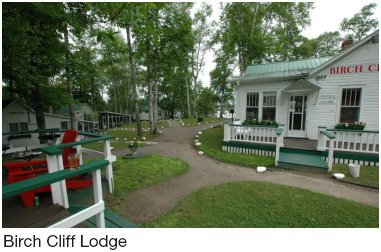
The main lodge, the original Mulcahey home
built around 1917, contained the dining
room and kitchen, and later an office,
store and lounge. Most early guests
came from Ohio, Pennsylvania and New
Jersey. Birch Cliff Lodge was a full service
American Plan fishing lodge, with cottage
names such as Bide-a-Wee, Linger
Long, Restin Up, and Dunworryn. A large
fleet of flat-bottomed wooden boats,
painted white with green trim and powered
by five horsepower motors, took
guests and their guides fishing. In the
1930s and 1940s, fishing lodges such as
these provided employment for a large
number of guides, supplying much-needed
income for year-round residents. Chief
Jean, son Sam and grandson Jack Baptiste
were prominent fishing and hunting
guides during this period. Since David
Milne purchased the resort in 1983, it
has been remodeled and upgraded to a
four-star level, so that Birch Cliff Lodge
continues to be one of the most attractive
and historically representative cottage resorts
in Ontario.
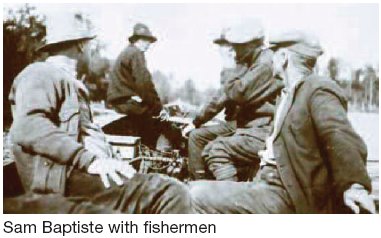
Rangers Lodge also began in 1931. On
July 15 of that year, the Wigwassin Post of
the Rangers was founded by the first five
boys who had been guests that summer.
The Post Lodge, completed in June 1932,
was constructed of white pine logs. It was
60' by 60', including a 20' verandah that
ran the length of the building. Of the 15
rooms, 10 were allotted to the boys, sleeping
four to a room with two double bunk
beds, or "lumberjack style", as they called
it. Applications were limited to 40 in order
to ensure that each boy received sufficient
attention and instruction.
The Post was organized on a quasi-military style, and was advertised as a "summer camp in the Canadian North for America's finest boys". It was operated under the Command and Direction of Glenn R. Snodgrass, who graduated from the University of Illinois in 1923 and was Director of Physical Training at a large high school in the Philadelphia suburbs. The Post Physician was Dr. W. Vance and the Quartermaster was C.C. Basnett, an expert camper, woodsman and sportsman, who also looked after supplies and accounting. Both were from West Virginia. Besides learning outdoor skills, the boys had access to a photo dark room, a laboratory, a taxidermy shop, and woodworking equipment. Boys were taught the proper use and handling of a rifle.
Parents could send their boys by train to Rochester, New York, where the Post Commander personally took charge of their trip. They boarded a steamer, the "Montreal", at Genesee, New York in the morning and arrived in Coburg, Ontario in the afternoon, and completed the trip by train to Baptiste Station. The Rangers were encouraged to purchase a uniform sold at a cost of $25, consisting of a powder-blue, double-breasted tunic, light buff riding breeches with scarlet braid on the outside seam, black leather puttees, white felt hat patterned after the Northwest Mounted Police, and a scarlet Sam Browne belt. Rangers also had to bring their own blankets, pillows, raincoat, towels, athletic equipment, a 22-calibre, single-shot rifle of good quality, any musical instrument, and a Testament or Bible.
Rangers Lodge was subsequently used as a wilderness "get away" for wealthy Americans, and the final owner was Ron Schnurpel, who operated the lodge from 1958 until 1996, when he closed the lodge after subdividing the property in 1979.
Herschel Island is a 14-acre island located in the main basin of Baptiste Lake, and is accessible by a 1.5 mile boat ride from Birch Cliff Lodge.
The Post was organized on a quasi-military style, and was advertised as a "summer camp in the Canadian North for America's finest boys". It was operated under the Command and Direction of Glenn R. Snodgrass, who graduated from the University of Illinois in 1923 and was Director of Physical Training at a large high school in the Philadelphia suburbs. The Post Physician was Dr. W. Vance and the Quartermaster was C.C. Basnett, an expert camper, woodsman and sportsman, who also looked after supplies and accounting. Both were from West Virginia. Besides learning outdoor skills, the boys had access to a photo dark room, a laboratory, a taxidermy shop, and woodworking equipment. Boys were taught the proper use and handling of a rifle.
Parents could send their boys by train to Rochester, New York, where the Post Commander personally took charge of their trip. They boarded a steamer, the "Montreal", at Genesee, New York in the morning and arrived in Coburg, Ontario in the afternoon, and completed the trip by train to Baptiste Station. The Rangers were encouraged to purchase a uniform sold at a cost of $25, consisting of a powder-blue, double-breasted tunic, light buff riding breeches with scarlet braid on the outside seam, black leather puttees, white felt hat patterned after the Northwest Mounted Police, and a scarlet Sam Browne belt. Rangers also had to bring their own blankets, pillows, raincoat, towels, athletic equipment, a 22-calibre, single-shot rifle of good quality, any musical instrument, and a Testament or Bible.
Rangers Lodge was subsequently used as a wilderness "get away" for wealthy Americans, and the final owner was Ron Schnurpel, who operated the lodge from 1958 until 1996, when he closed the lodge after subdividing the property in 1979.
Herschel Island is a 14-acre island located in the main basin of Baptiste Lake, and is accessible by a 1.5 mile boat ride from Birch Cliff Lodge.
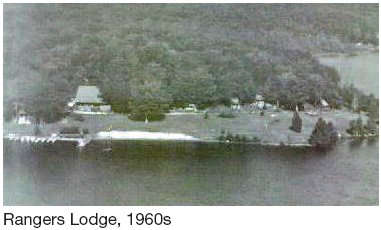
In the early 1930s,
the island was purchased by Niagara Light
and Power of Niagara Falls, New York for
use by its executives as a private fishing
club. Guests sometimes arrived by private
railcar, and the island became known locally
as 'Millionaires Island'. The Herschel
Island Fishing Club accommodated 18
guests. It had a main lounge room with
stone fireplace, a dining room, a bar, a
kitchen and dining room, and a sunroom.
A passenger boat and a luggage scow
would take guests to the island, and a tiny
electric railroad would take them and their
bags from the main dock to the main lodge
(these are still visible today on the south
shore of the island). The island currently
belongs to Birch Cliff Lodge owner David
Milne, who has refurbished the facilities to
their previous glory.
Camp Ponacka was initially founded in 1932 by a Pennsylvania high-school teacher named Lester Bergey, who ran it as a boys camp until 1939, thereafter using it as cottage retreat for his family and friends. In the fall of 1946, Bruno Morawetz, a 29-year-old, second-year philosophy student at the University of Western Ontario in London, purchased the stretch of shoreline with three buildings for $4,500. In July 1947, the camp's first 12 boys (mostly from London) arrived in Baptiste Village by train and traveled over to the camp by boat. In the early days, the camp's facilities were rustic; milk and other perishables were kept in an icehouse (now the camp's Lapidary Hut). In 1958, a road was opened to the camp, and electricity arrived shortly after.
Camp Ponacka was initially founded in 1932 by a Pennsylvania high-school teacher named Lester Bergey, who ran it as a boys camp until 1939, thereafter using it as cottage retreat for his family and friends. In the fall of 1946, Bruno Morawetz, a 29-year-old, second-year philosophy student at the University of Western Ontario in London, purchased the stretch of shoreline with three buildings for $4,500. In July 1947, the camp's first 12 boys (mostly from London) arrived in Baptiste Village by train and traveled over to the camp by boat. In the early days, the camp's facilities were rustic; milk and other perishables were kept in an icehouse (now the camp's Lapidary Hut). In 1958, a road was opened to the camp, and electricity arrived shortly after.
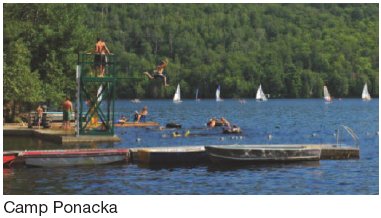
After 35 years, Bruno and his wife Gwen finally
relented and brought telephone service
into the camp. Canoe trips into Algonquin
Park began in 1949, while horseback riding
was added to the program in 1960.
The construction of a new dining hall in
1964 enabled Ponacka to significantly expand
its enrollment. In 1985, Bruno and
Gwen welcomed their daughter, Anne
Morawetz and her husband Don Bocking,
who assisted them in running Camp
Ponacka, and eventually purchased the
camp over time. New programs and activities
were added. Ponacka's adventure
programs enable boys to go hiking in the
Adirondacks in upper New York State,
enjoy biking trips to the Haliburton Forest
Reserve, and white water paddling on the
nearby Madawaska River. Today, Camp
Ponacka is one of Ontario's most respected
summer camps for boys, with an
enrollment of 155 boys from the ages of
eight to 15.
Do you know a piece of Baptiste Lake History? Share it with us.



Advertise Here!
For information on advertising on the BLA website and in the BLA newsletter, contact the BLA at MyBaptisteLake@gmail.com
Support The BLA, Make A Donation.

